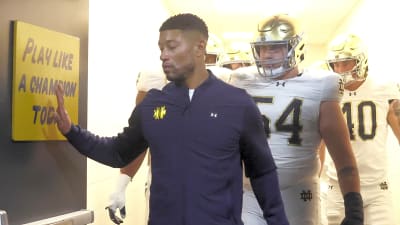- Home
- Quizzes
- My Quiz Activity
- Newsletters
- MY FAVORITES
- Add Sports/Teams
- SPORTS
-
NFL
- NFL Home
- Arizona Cardinals
- Atlanta Falcons
- Baltimore Ravens
- Buffalo Bills
- Carolina Panthers
- Chicago Bears
- Cincinnati Bengals
- Cleveland Browns
- Dallas Cowboys
- Denver Broncos
- Detroit Lions
- Green Bay Packers
- Houston Texans
- Indianapolis Colts
- Jacksonville Jaguars
- Kansas City Chiefs
- Las Vegas Raiders
- Los Angeles Chargers
- Los Angeles Rams
- Miami Dolphins
- Minnesota Vikings
- New England Patriots
- New Orleans Saints
- New York Jets
- New York Giants
- Philadelphia Eagles
- Pittsburgh Steelers
- San Francisco 49ers
- Seattle Seahawks
- Tampa Bay Buccaneers
- Tennessee Titans
- Washington Commanders
-
MLB
- MLB Home
- Athletics
- Arizona Diamondbacks
- Atlanta Braves
- Baltimore Orioles
- Boston Red Sox
- Chicago White Sox
- Chicago Cubs
- Cincinnati Reds
- Cleveland Guardians
- Colorado Rockies
- Detroit Tigers
- Houston Astros
- Kansas City Royals
- Los Angeles Angels
- Los Angeles Dodgers
- Miami Marlins
- Milwaukee Brewers
- Minnesota Twins
- New York Yankees
- New York Mets
- Philadelphia Phillies
- Pittsburgh Pirates
- San Diego Padres
- San Francisco Giants
- Seattle Mariners
- St. Louis Cardinals
- Tampa Bay Rays
- Texas Rangers
- Toronto Blue Jays
- Washington Nationals
-
NBA
- NBA Home
- Atlanta Hawks
- Boston Celtics
- Brooklyn Nets
- Charlotte Hornets
- Chicago Bulls
- Cleveland Cavaliers
- Dallas Mavericks
- Denver Nuggets
- Detroit Pistons
- Golden State Warriors
- Houston Rockets
- Indiana Pacers
- Los Angeles Clippers
- Los Angeles Lakers
- Memphis Grizzlies
- Miami Heat
- Milwaukee Bucks
- Minnesota Timberwolves
- New Orleans Pelicans
- New York Knicks
- Oklahoma City Thunder
- Orlando Magic
- Philadelphia 76ers
- Phoenix Suns
- Portland Trail Blazers
- Sacramento Kings
- San Antonio Spurs
- Toronto Raptors
- Utah Jazz
- Washington Wizards
-
NHL
- NHL Home
- Anaheim Ducks
- Boston Bruins
- Buffalo Sabres
- Calgary Flames
- Carolina Hurricanes
- Chicago Blackhawks
- Colorado Avalanche
- Columbus Blue Jackets
- Dallas Stars
- Detroit Red Wings
- Edmonton Oilers
- Florida Panthers
- Los Angeles Kings
- Minnesota Wild
- Montreal Canadiens
- Nashville Predators
- New Jersey Devils
- New York Islanders
- New York Rangers
- Ottawa Senators
- Philadelphia Flyers
- Pittsburgh Penguins
- San Jose Sharks
- Seattle Kraken
- St. Louis Blues
- Tampa Bay Lightning
- Toronto Maple Leafs
- Utah Mammoth
- Vancouver Canucks
- Vegas Golden Knights
- Washington Capitals
- Winnipeg Jets
- NCAAF
- NCAAM
- Olympics
- Boxing
- Entertainment
- Lifestyle
- Golf
- MMA
- Soccer
- Tennis
- Wrestling
- Sports Betting
- More Sports
- RESOURCES
- My Account
- YB on Facebook
- YB on Twitter
- YB on Flipboard
- Contact Us
- Privacy Policy
- Terms of Service

Who had the greatest QB season for every NFL team?
Measuring NFL passing statistics across eras is difficult, as the game regularly changes, most benefiting modern quarterbacks. Here is an effort to do so. With some players included for multiple teams and nine decades represented, here is the best QB season in every franchise's history.
Arizona/St. Louis Cardinals: Neil Lomax (1984)
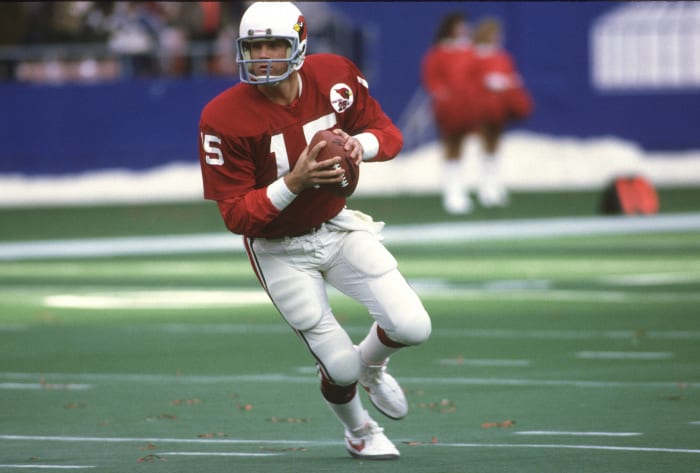
In a near-dead heat with Carson Palmer's 2015 season, Lomax's 1984 brought a greater degree of difficulty. In addition to defenses' increased freedom in this era, Lomax played for a Cardinals team in a deep NFC East and did so for a frugal franchise in the pre-free agency era. Lomax's 4,614 yards ranked fourth all-time as of 1984, and his Pro Bowl season powered the Cardinals to 9-7 and on the cusp of a division title. The fourth-year QB wrapped his 28-touchdown season with 468 yards and two TD passes, as converted DB Roy Green shredded defenses in '84 as well, in a narrow loss to Washington in a do-or-die game.
Atlanta Falcons: Matt Ryan (2016)
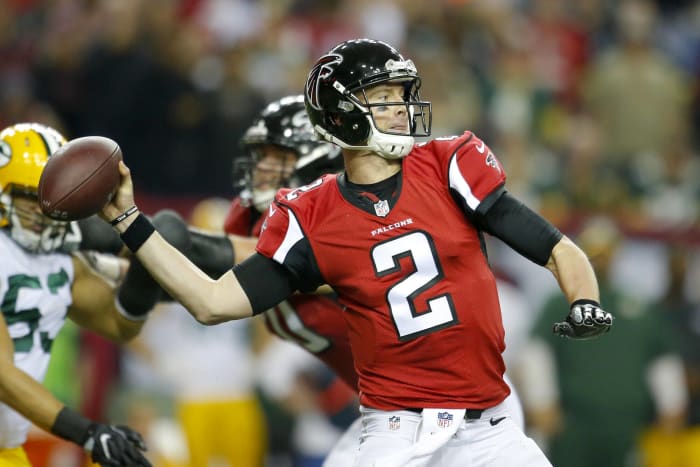
The 2016 Falcons' 33.8 points remain tied for eighth in the Super Bowl era, and Ryan operated as the pilot. Kyle Shanahan's second season as Atlanta's offensive coordinator lifted Ryan to a new level. The midcareer peak included a 38-7 TD-INT ratio, 4,944 yards and a 9.3 yards-per-attempt number. Although Tom Brady played well upon returning from Deflategate, Ryan being the conductor of the NFL's best offense -- which keyed an 11-5 season and a No. 2 seed -- lifted him to the only MVP in Falcons history. Ryan added seven TD tosses during a lopsided NFC playoff journey and was in a groove for three quarters in Super Bowl LI.
Baltimore Ravens: Lamar Jackson (2024)

Statistically, few seasons have outpaced Jackson's seventh. The NFL's preeminent dual threat combined 4,172 passing yards with 915 on the ground, doing so while putting together a 41-4 TD-INT ratio. Adding four more rushing TDs, Jackson also led the NFL with 8.8 yards per attempt. This was better than his 2019 breakthrough. While it did result in Jackson's third first-team All-Pro honor, it was not enough for a third MVP. Jackson's Ravens losing to the woeful Raiders and Browns may have dinged him, as did a lack of previous playoff success. The QB also committed two turnovers in a crushing divisional-round loss to the Bills. This was a historic season for AFC QB play.
Buffalo Bills: Josh Allen (2024)
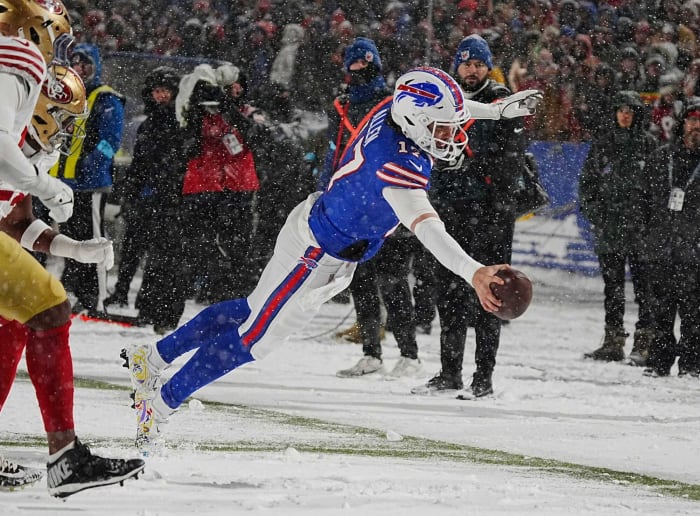
Bumping 1991 Jim Kelly out of this space, Allen edged Lamar Jackson for MVP honors. Even if voters were hesitant about giving Jackson a third MVP, Allen powered ahead after losing his top two wideouts. After Stefon Diggs and Gabe Davis' exits, the dual-threat QB accounted for 40 touchdowns (12 rushing) and paired 3,731 passing yards with 531 on the ground. Allen's impact went beyond numbers, as his MVP came with one All-Pro teammate (while the Ravens had eight). Allen scored on a pass he threw, via lateral from Amari Cooper, and willed the Bills to wins over the Lions and Chiefs. Though, Kansas City's playoff mastery of Buffalo struck again in the AFC title game.
Carolina Panthers: Cam Newton (2015)
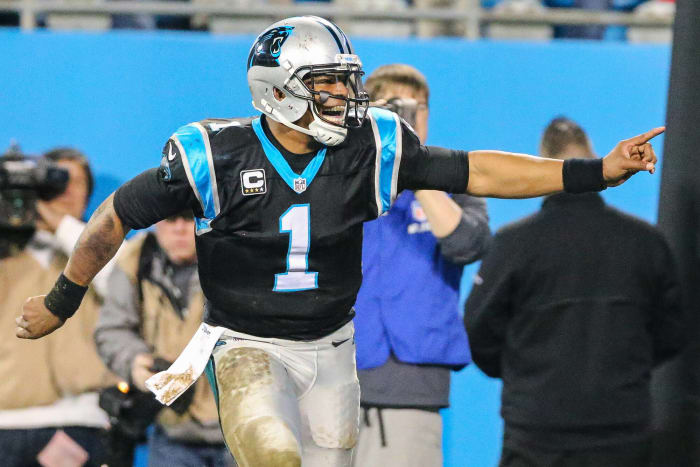
While this became an outlier campaign, Newton offered a glorious display of athleticism and passing capabilities in his fifth season. The former No. 1 pick dominated on the ground and delivered through the air despite No. 1 wide receiver (at that time, at least) Kelvin Benjamin suffering a season-nullifying injury in camp. The Panthers extended Newton that offseason and saw him post 3,837 passing yards and rush for 636, combining for 45 TDs. The virtuoso display led the Panthers to a 15-1 record and an NFC title. A rough Super Bowl against a fearsome Broncos defense, however, served as a turning point for Newton, who never made a Pro Bowl after this season.
Chicago Bears: Sid Luckman (1943)
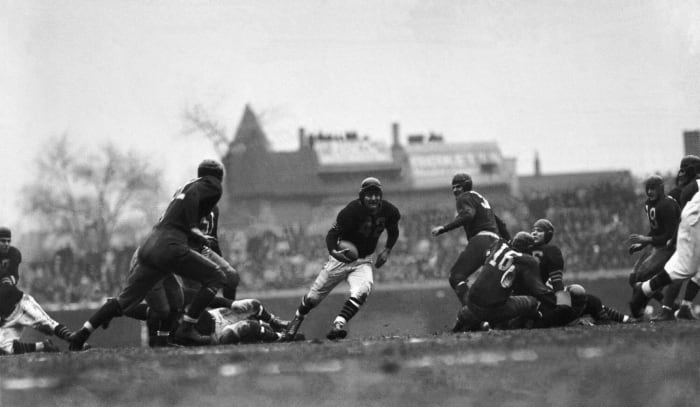
Due respect to Jim McMahon and Jay Cutler, this is not close. The greatest QB in Bears history, Luckman powered the Bears to another title in 1943. The fifth-year passer shattered Cecil Isbell's record for TD passes in a season, throwing 28 compared to just 12 INTs. Adjusted for era, this is an astonishing display. Luckman's 10.9 yards per attempt from '43 remains the NFL single-season record, and his outing against Washington in the NFL title game stands as an all-time championship performance. Luckman, who threw a record-setting seven TDs against the Giants in Week 8, buried Sammy Baugh's team with five TD passes (and no picks) in a 41-21 clincher.
Cincinnati Bengals: Ken Anderson (1981)
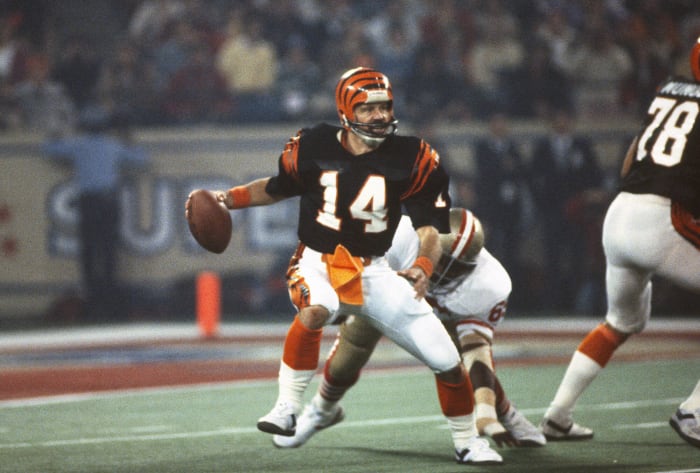
Completion percentages have steadily risen as a whole, but in the 1970s and '80s, it was not uncommon to see the best passers fail to reach 60% in a season. Operating for a chunk of his career in a Bill Walsh-orchestrated offense, Anderson was ahead of his time. This was not one of the Bengals starter's best accuracy slates, but he bounced back from an injury-prone stretch to throw a career-high 29 TD passes and post 7.8 yards per attempt. At 32, Anderson won an MVP and piloted the Bengals to a 12-4 season and their first Super Bowl. Boomer Esiason's 1988 and two Joe Burrow efforts came close; Anderson's efficiency en route to Super Bowl XVI wins out.
Cleveland Browns: Otto Graham (1954)
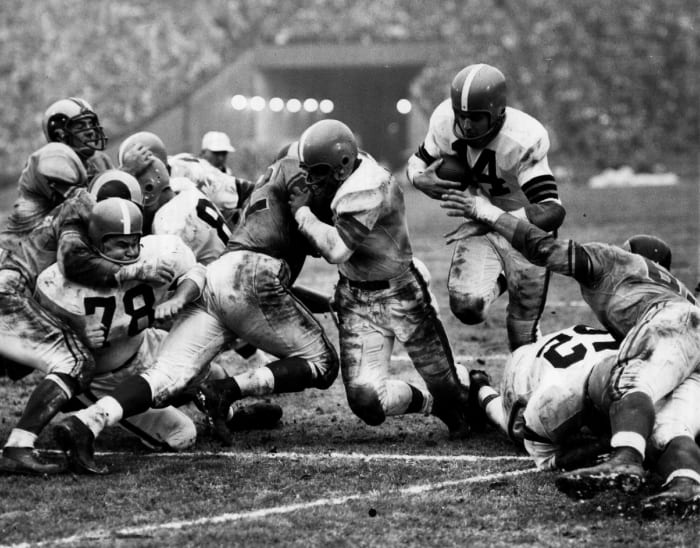
With respect to Brian Sipe and the Kardiac Kids, this boils down to picking a Graham season. The top quarterback of his era and future All-Century-teamer, Graham went to an NFL championship game in each of his six seasons in the league. We will exclude Otto's four All-American Football Conference years; that still leaves three MVP seasons and three championship years. This is not one of Graham's MVP years; he finished second to 49ers RB Joe Perry. But Graham earned All-NFL acclaim and mowed down the Lions in the title game, throwing three TD passes and running for three more scores. No QB has matched Graham's championship-stage effort, which came in a 56-10 romp.
Dallas Cowboys: Roger Staubach (1977)
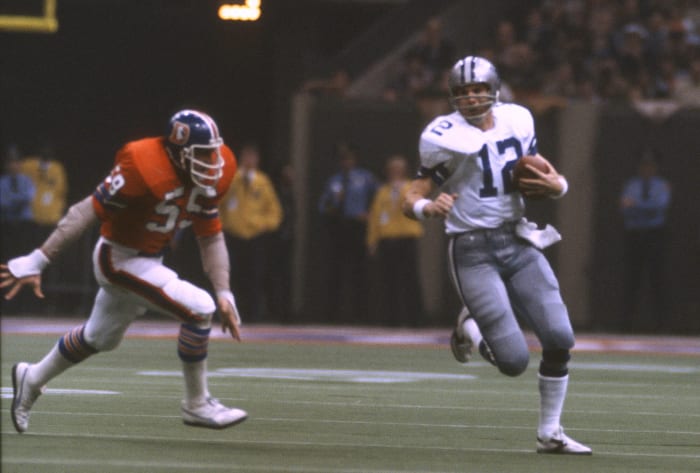
Staubach was still playing like a top-end quarterback in his mid-30s and until his age-37 finale, closing out his career as the 1970s' best QB. Choosing between Captain Comeback's 1977 and '78 seasons is difficult, with the Dallas icon's stats superior in his penultimate season. But the seminal 1978 rule changes unleashing QBs matter here, as does the Cowboys' Super Bowl XII title. Staubach notched a better completion percentage in 1977, despite increased defensive freedom, and piloted the Cowboys to a 15-2 mark that included three comfortable playoff wins. Throwing just nine INTs in '77, Staubach's age-35 slate included three game-winning drives.
Detroit Lions: Bobby Layne (1951)
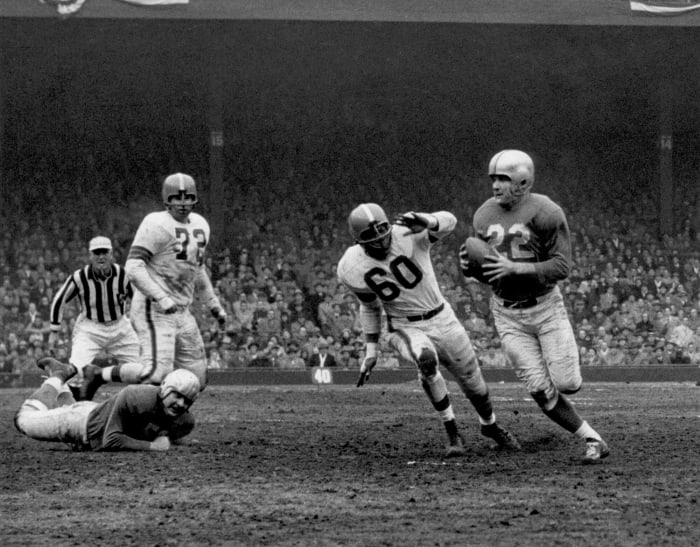
Graham's chief rival, Layne did get the better of him in two of the teams' three championship meetings. This preceded Layne's back-to-back titles, but the gunslinging Texan threw a career-high 26 TD passes (and a career-most 23 INTs) while picking up his first Pro Bowl honor. Layne led the NFL in TDs, completions and passing yards (2,403). The Detroit gunslinger set the stage for the Lions' ascent during this season, his fourth in the NFL and a 7-4-1 Lions campaign. Layne enjoyed a five-game midseason stretch of at least three TD passes in each, an extraordinarily rare feat for this era.
Denver Broncos: Peyton Manning (2013)
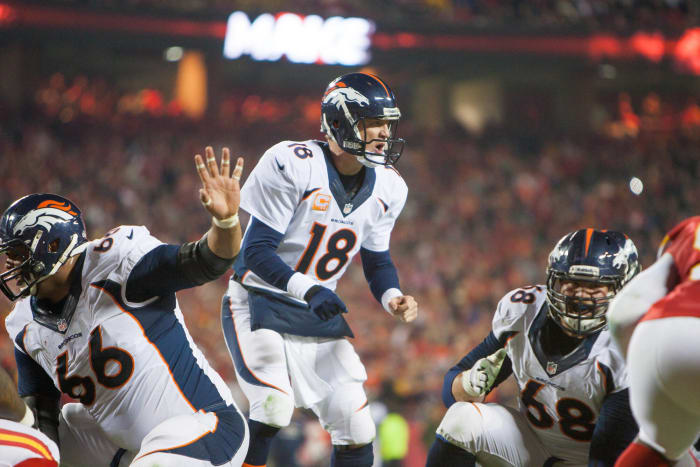
It may seem preposterous to not see John Elway's name here, but by midseason 2012, Manning was back in his best form. The effects from the legendary passer's neck surgeries still left him limited, but the Broncos offense reached new territory in 2013. Less reliant on the Colts scheme compared to 2012, the Broncos set a still-standing NFL scoring record (606 points). Five Broncos scored at least 10 TDs, an NFL first. It all hinged on Manning, who sliced up defenses despite arm-strength limitations. Even with the move to 17 games, no QB has seriously threatened Manning's 55 TDs. His 5,477 yards remain a record as well. While an injury-riddled Broncos team folded in Super Bowl XLVIII, Manning added 400 yards to topple the Patriots in the AFC title game.
Green Bay Packers: Aaron Rodgers (2011)
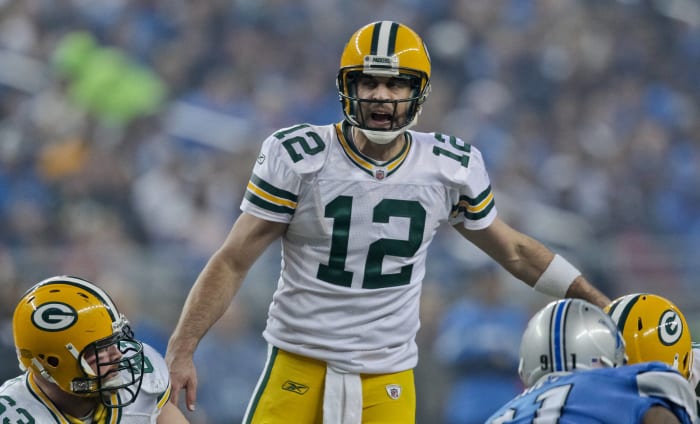
Coming off a breakthrough playoff effort to seal the Packers' fourth Super Bowl, Rodgers made another leap in his fourth season. Rodgers ran away with MVP honors in his age-27 season. The efficiency maestro tossed 45 touchdown passes and just six interceptions -- one of his six seasons with at least 37 TDs and fewer than eight INTs. Rodgers led the Packers to a 15-1 record and broke the passer rating mark by posting a 122.5 figure that still leads the pack. While the Pack rallied from the No. 6 seed to a Super Bowl title in 2010, the No. 1-seeded '11 team lost 37-20 to the Giants in its opener. This became a January trend for the Packers.
Houston Texans: C.J. Stroud (2023)

When comparing Stroud's rookie slate to Deshaun Watson's three-year run, it is important to recall where the Texans were during the two years since Watson's off-field saga engulfed the team. Houston (seven wins from 2021-22) rocketed back to the playoffs with Stroud, who dominated at points despite a middling-at-best skill-position group. Despite losing Tank Dell in Week 13, the Texans went 10-7 and saw Stroud run away with Offensive Rookie of the Year honors. The No. 2 overall pick hit 4,108 yards (8.2 per attempt) despite missing nearly three games. Drawing shrieks of horror from Panthers fans, Stroud led the NFL in INT rate and scorched the top-ranked Browns pass defense in the wild-card round.
Indianapolis Colts: Peyton Manning (2004)
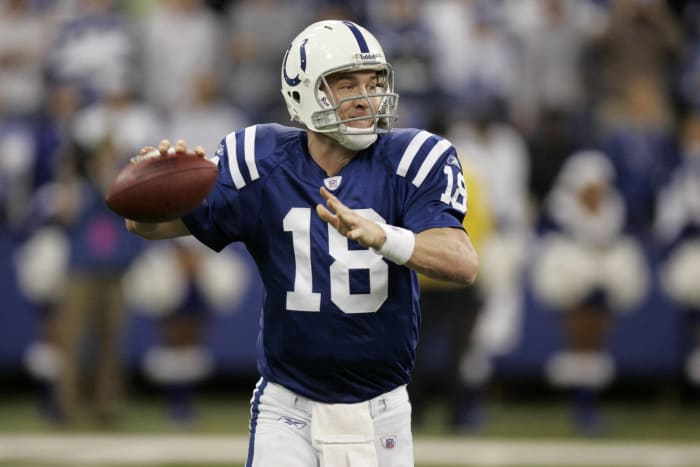
After a quick ascent in 1999, Manning remained elite until late in his penultimate season. One of his peaks came in 2004, when Dan Marino's longstanding single-season touchdown pass record fell. Granted, 2004 brought friendlier confines for aerial dominance, but only Marino and Kurt Warner had previously thrown 40-plus TDs in a season. Manning tossed 49, breaking the record in Week 16. Manning led the NFL with 9.2 yards per pass, by far his career high, and guided the Colts to a 12-4 record. He punctuated this with one of the great playoff outings, shredding the Broncos (458 yards, four TDs) in the wild-card round for a second straight year.
Jacksonville Jaguars: Mark Brunell (1996)
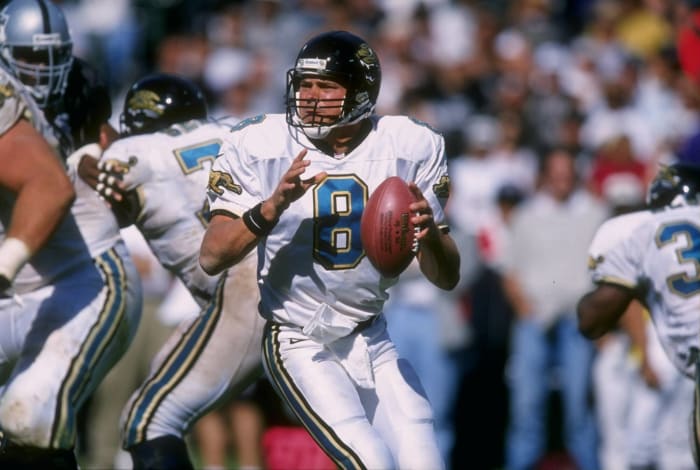
Rules at the time gave the Jaguars and Panthers smoother runways as expansion teams compared to the Browns and Texans. Still, it was shocking to see both reach the conference championship round in Year 2. Brunell played the lead role in Jacksonville doing so. Despite the Jags starting 2-6, they ended up in the playoffs. The ex-Brett Favre backup led the NFL in passing yards and yards per attempt (4,367, 7.8), making his first Pro Bowl. Brunell also threatened teams on the ground, best illustrated by his two-way day in a historic upset of the No. 1-seeded Broncos in the divisional round. A 1997 knee injury limited Brunell's scrambling moving forward, making '96 the choice.
Kansas City Chiefs: Patrick Mahomes (2018)
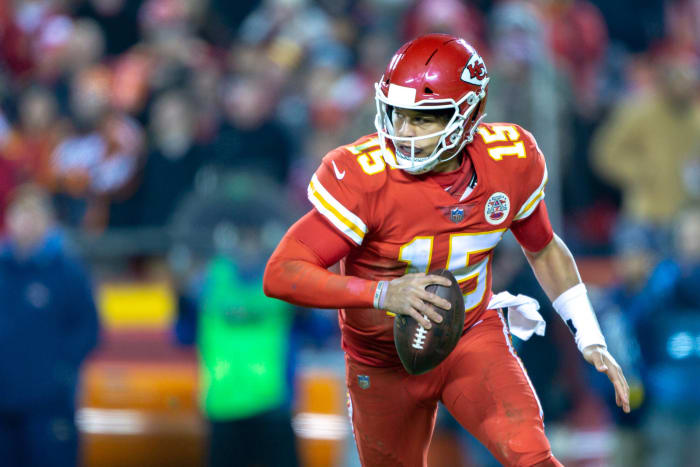
The gold standard for a QB onramp in the modern NFL, the Chiefs waited a year to deploy their franchise-changing weapon. The 2017 Alex Smith backup became one of the 21st century's great insta-superstars in any sport, needing no acclimation period once unleashed in 2018. Mahomes immediately dragged the Chiefs up a level, after they had been trapped on the second tier for years, and finished with the NFL's third 50-touchdown pass season. The Texas Tech-trained talent needed to win shootouts to cover for a bad Kansas City defense, adding 5,097 yards to go with 272 on the ground. While the Patriots prevailed in an AFC title game duel, Mahomes ensured the Chiefs would take their throne soon.
Las Vegas/Oakland Raiders: Ken Stabler (1976)
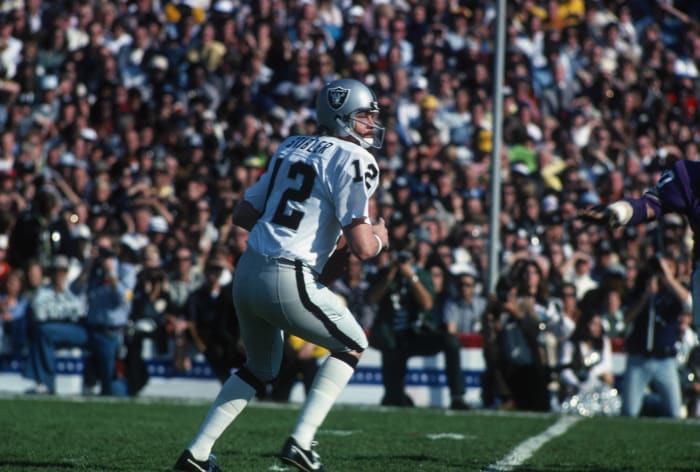
Stabler won MVP acclaim in 1974, his second year as a starter. He bettered that season two years later. The Raider legend led a 16-1 run to Super Bowl XI, lifting the perennial AFC contender over a long-formed barrier. Stabler led the NFL with a career-high 27 touchdown passes and with a 66.7% completion rate -- nearly five percentage points above the field -- while posting a 9.4 yards-per-attempt figure that still ranks in a tie for 11th all-time. A historic O-line quintet blocked for Stabler, who targeted Hall of Famers Cliff Branch and Fred Biletnikoff. "The Snake" did not throw an interception in the playoffs.
Los Angeles Chargers: Dan Fouts (1981)
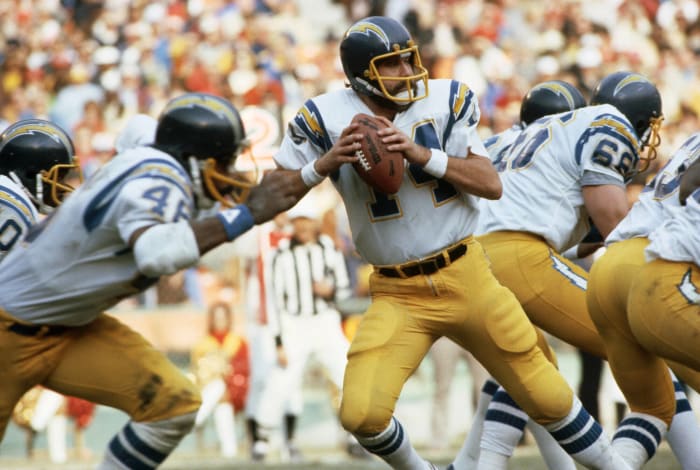
Fouts finished second in the MVP voting in 1979 and 1982, and the 1980 Chargers became the first team to feature three 1,000-yard receivers in a season. But Fouts was still at his apex in 1981, when he tallied a career-most 33 TD passes and dropped his INT total despite throwing a career-high 609 passes. The Air Coryell pilot managed this despite the Chargers controversially trading All-Pro wideout John Jefferson early in the season, replacing him with the Saints' Wes Chandler. The Bolts kept going, and Fouts broke his own NFL single-season yardage record (4,802). The easy clincher for Fouts' 1981 here: the Hall of Famer's 433-yard masterpiece in the divisional round's "Epic in Miami."
Los Angeles/St. Louis Rams: Kurt Warner (1999)
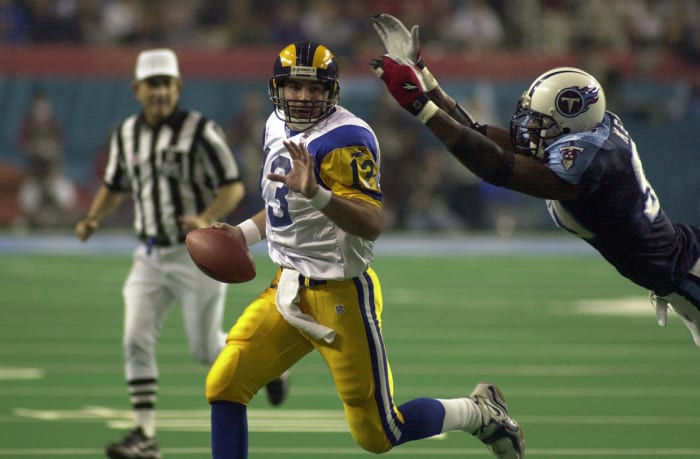
With Norm Van Brocklin and Bob Waterfield splitting time for the record-setting early-1950s Rams, this boiled down to 28-year-old Warner vs. his 30-year-old version. Warner was statistically better in several areas in 2001, but it is difficult to overstate the astonishment the '99 Rams created. Trent Green's late-summer replacement became the only non-Dan Marino QB to throw 40-plus TDs in a season (41), and he led the NFL in both completion percentage (65.7) and yards per pass (8.7). Obviously, separating 1999 from 2001: the Rams' Super Bowl XXXIV triumph. Warner set a Super Bowl passing record, with 414 yards, and hit Isaac Bruce for an 80-yard game-winner.
Miami Dolphins: Dan Marino (1984)
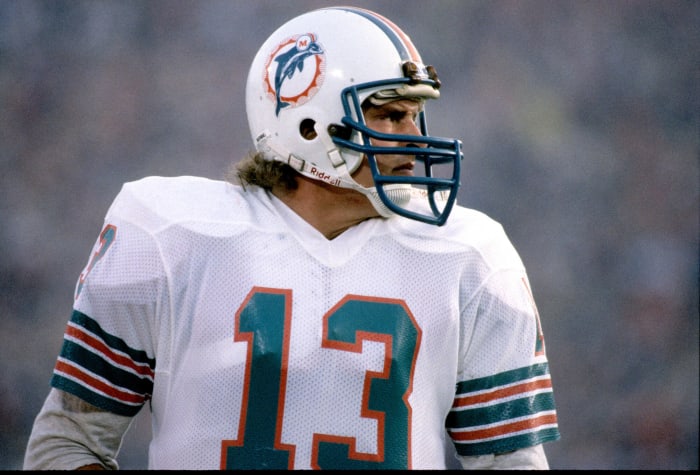
While Fouts had taken the passing yardage record past 4,800, Y.A. Tittle still held the single-season TD mark entering 1984. Marino laid waste to the 21-year-old record by Week 13, having broken Tittle's mark by 12 at season's end. He wrapped the season with three straight four-TD games. Marino threw 48 touchdown passes; only three teams scored that many TDs in 1984. The second-year prodigy added 5,084 yards, being the NFL's only 5,000-yard passer for 23 years. By the time Drew Brees joined him, numerous rule changes tilted toward passers. After a 14-2 Dolphins season, Marino added seven more TD tosses in Miami's two playoff wins -- both blowouts. This remains the NFL's gold-standard QB season.
Minnesota Vikings: Randall Cunningham (1998)
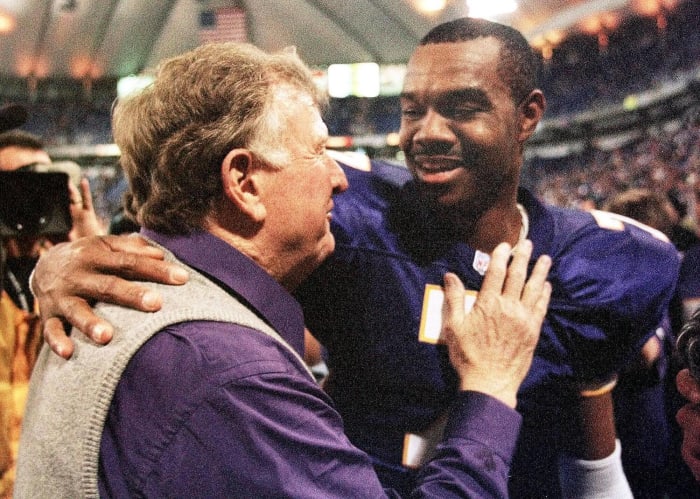
Fran Tarkenton won the 1975 MVP award, but it took a 2,000-yard Terrell Davis season to deny Cunningham 23 years later. Dennis Green lured the ex-Eagle dynamo out of retirement in 1997 as a Brad Johnson backup. An early-season Johnson injury led to 14 Cunningham starts and an NFL single-season scoring record. Operating more from the pocket compared to his Philly days, Cunningham enjoyed a top-class arsenal. Minnesota drafted Randy Moss to round out its Cris Carter-Jake Reed-Robert Smith skill-position crew, and Cunningham ended the year with 34 TD passes and a career-high (by a mile) 8.7 yards per attempt. The Vikings went 15-1, seeing a late-game field goal miss deny them a shot at Super Bowl XXXIII.
New England Patriots: Tom Brady (2007)
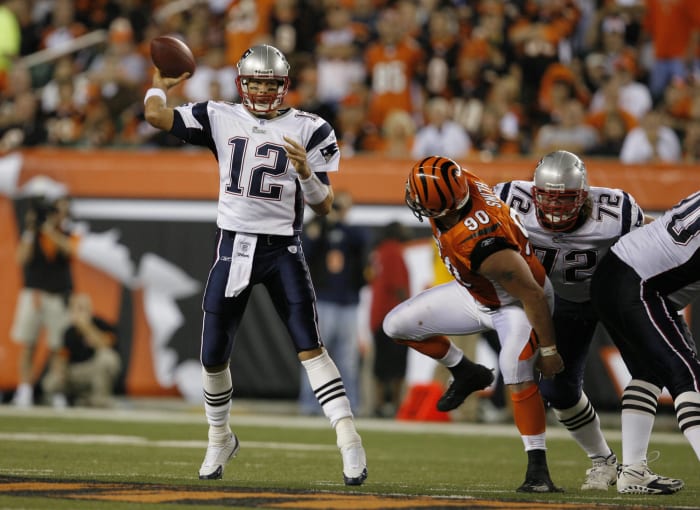
While highly regarded, Brady had been viewed as a great quarterback who benefited from elite defenses and lacked statistical dominance. That changed in 2007, when it became immediately evident what Moss would do for the Patriots. Stolen from the Raiders for a fourth-round pick, Moss rediscovered his Minnesota form. No one has made a serious charge at his single-season receiving touchdown record (23) since. Brady threw 27 more TD passes, with trade pickup Wes Welker giving the Pats a slot maven and moving the NFL forward at that position. While the Pats peaked early, Brady threw for 4,806 yards and tossed just eight INTs. He had them at 18-0 before a titanic Giants upset.
New Orleans Saints: Drew Brees (2011)

Brees earned his only first-team All-Pro nod in 2006, his Saints debut, and finished with a record-smashing five 5,000-yard passing seasons. The pick here: not especially difficult. Brees broke Dan Marino's 27-year-old single-season passing yardage record in his sixth Saints slate, finishing with 5,476 yards and a career-high 46 TD passes. The Saints unleashed Jimmy Graham on the NFL in 2011, had Marques Colston in his prime and auxiliary playmakers Darren Sproles, Lance Moore and others around Brees. This produced a 13-3 season and a still-standing team total yardage record (7,474). The Saints went 13-3 and lost to the 49ers in a playoff classic.
New York Giants: Y.A. Tittle (1963)
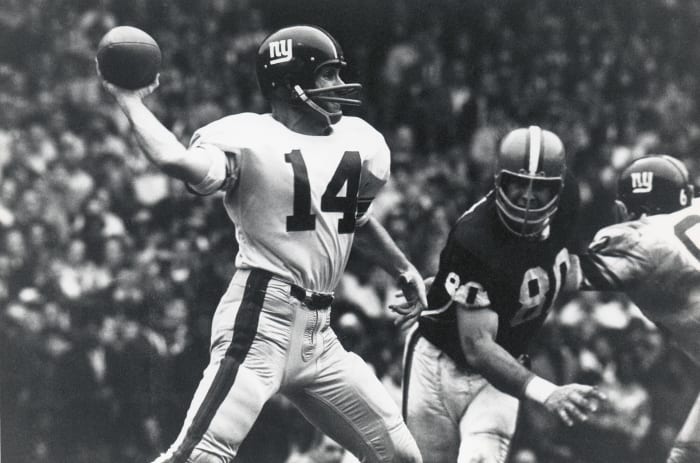
Eli Manning's 2011 postseason made this a close call, but Tittle delivered an ahead-of-its-time season at age 37. Tittle's penultimate season wrapped with 36 TD passes, breaking his own NFL record by three. Acquired from the 49ers in 1961, Tittle still had plenty in the tank. He threw eight more TDs than any other NFL QB that season, despite missing a game. He threw only 14 INTs and led the NFL in completion rate (60.2%) and yards per attempt (8.6), driving the Giants to a third straight NFL title game. Tittle's season was so good it beat out arguably Jim Brown's finest season for MVP honors. Although the 36 TDs tied George Blanda's AFL record, it did not fall until Marino's 1984.
New York Jets: Joe Namath (1968)
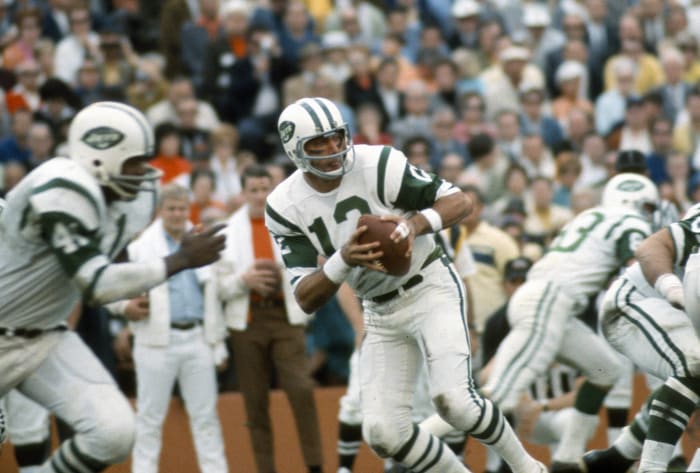
It should be noted Namath's 1967 was the NFL's first 4,000-yard passing season, and it stood as the single-season yardage record through the end of the 14-game era in 1978. But Broadway Joe led the AFL in INTs that year as well. And he orchestrated a pretty memorable follow-up. Namath's TD count dropped from 28 to 15 from 1967-68, but he won AFL MVP honors in his fourth season -- an 11-3 Jets campaign. Namath bettered his yards-per-attempt number in '68, at 8.3, and trimmed his INT count to 17. Playoff success makes this the easy choice, with the Jet legend tossing three TDs at a windswept Shea Stadium to oust the Raiders en route to Super Bowl III. His guarantee preceded pro football's defining upset.
Philadelphia Eagles: Randall Cunningham (1990)
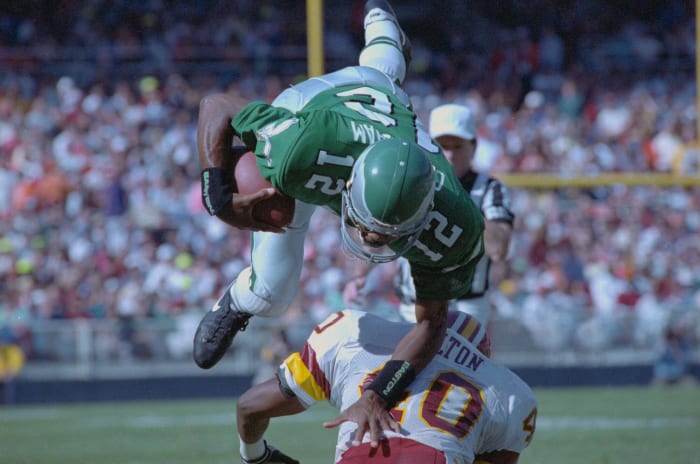
Norm Van Brocklin's final season resulted in a 10-2 Eagles record and the team's first championship, marking Vince Lombardi's only playoff loss as a head coach. But Cunningham turned in the Cam Newton pinnacle season 25 years early. Cunningham finished second to Joe Montana in MVP voting, one of four times the dual-threat demon collected an MVP silver. Cunningham fell just short of a 3,500-1,000 season, totaling 3,466 passing yards and 942 (eight per carry) on the ground. It can be argued Van Brocklin deserves the nod due to Cunningham being benched in a wild-card loss, but this ahead-of-its-time season -- which includes this legendary sequence -- is too flashy to ignore.
Pittsburgh Steelers: Terry Bradshaw (1978)
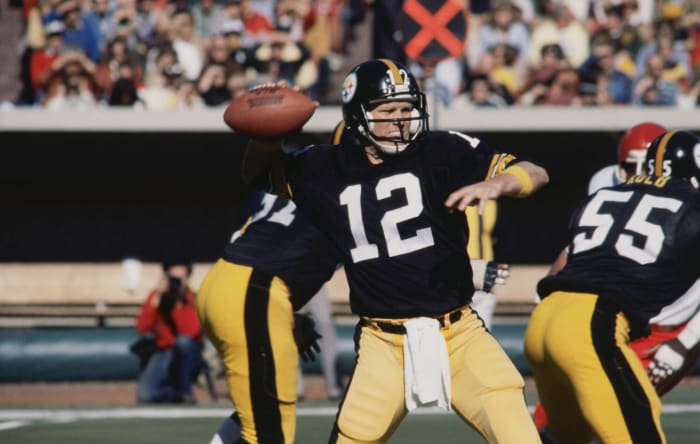
Named after longtime Bradshaw teammate Mel Blount, a 1978 rule change limited the amount of contact a defender could make on a receiver pre-pass. Along with O-linemen's options being expanded against pass rushers, 1978 was the seminal year for NFL aerial attacks. An inconsistent passer for many years, Bradshaw took advantage. Targeting Hall of Famers Lynn Swann and John Stallworth, Bradshaw soared to MVP honors in his ninth season. Pittsburgh's offense nearly caught up with the Steel Curtain, with Bradshaw throwing an NFL-high 28 TD passes and piloting the team to 14-2. Adding eight more playoff scores, Bradshaw won Super Bowl MVP honors with a 318-yard, four-TD outing to topple Dallas.
San Francisco 49ers: Joe Montana (1989)
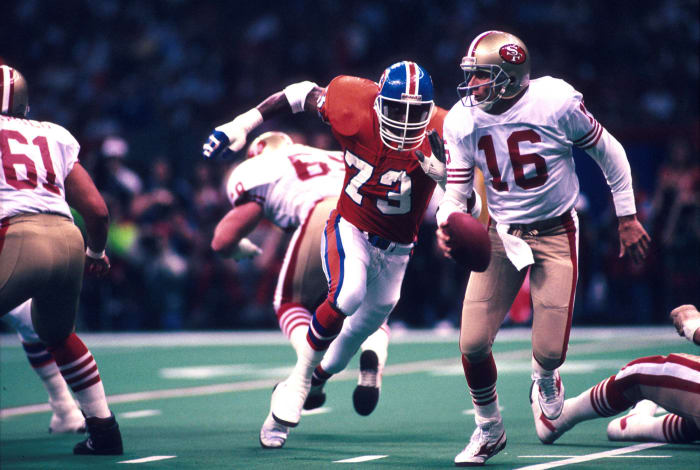
One of two state-of-the-art 49ers QB seasons, Montana's nips Steve Young's 1994 zenith due partially to the '89 team's invincibility aura. Granted, Montana's 49ers did not have to beat a team on the 1994 Cowboys' level, but they were so far above the opposition they did encounter. Montana missed three games but still threw 26 TD passes and 3,521 yards. Montana's per-play numbers (9.1 per attempt, 70.2 completion rate) lapped the field in the legend's age-33 season. Joe Cool's 11-0 TD-INT ratio in the playoffs, when the 49ers outscored competition 126-26, creates some distance here. The injury-prone icon was flawless that January, putting the 1989 49ers in the conversation for greatest team ever.
Seattle Seahawks: Russell Wilson (2015)

In the mid-2010s, the Seahawks morphed from a defense-powered operation centered around the Legion of Boom into a Wilson-centric team. The best of both worlds came in 2015, when Seattle sported the No. 1 scoring defense and Wilson took off. Wilson threw 34 touchdown passes and eight interceptions, adding 553 rushing yards. The fourth-year passer tossed just one INT over the Hawks' final seven games. From Weeks 10-14, Wilson threw 19 TD passes and no INTs and carried a 120-plus passer rating each week. This is the only such five-game stretch in NFL history. The Seahawks finished 10-6, advancing to the divisional round.
Tampa Bay Buccaneers: Tom Brady (2021)
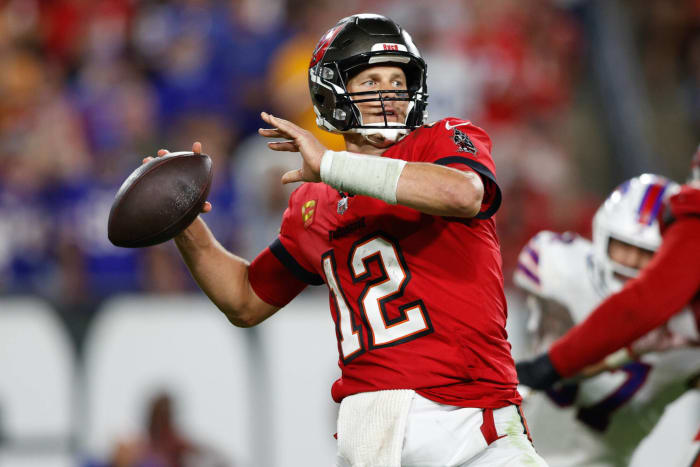
Making his second appearance here, Brady was in better form in his second season compared to the Buccaneers' Super Bowl LV-winning campaign. Closing his case as the greatest quarterback ever, the 44-year-old NFL deity led the league with 43 touchdown passes and a career-high 5,316 yards. The Bucs had shifted to more of a Brady-centric offense in 2021, and late-career mercenaries Rob Gronkowski and Antonio Brown made contributions. Brown did combust infamously late in the season, making Brady's endorsement look foolish, but the Bucs finished 13-4 and nearly rallied from 24 points down in a narrow divisional-round loss to the Rams.
Tennessee Titans/Houston Oilers: George Blanda (1961)

Steve McNair won the 2003 MVP, and Warren Moon capitalized on a QB-friendly Run and Shoot system en route to the Hall of Fame. Blanda, who played from 1949-75, did the best single-season work by collecting AFL MVP honors in his second Oilers slate. Blanda's 36 touchdown passes -- in a 14-game season -- set a single-season record that stood until Marino's 1984 bonanza. Blanda's work helped receivers Charley Hennigan and Bill Groman to dominance; Hennigan's 1,746 receiving yards were the single-season standard until Jerry Rice got there in 1995. Blanda's five INTs in the 1961 AFL title game -- a 10-3 win over the Chargers -- are not enough to dock him.
Washington: Sammy Baugh (1947)
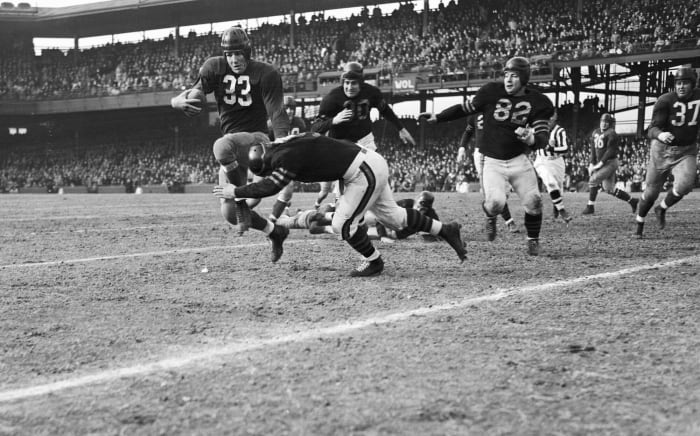
Multiple Baugh seasons, as well as Joe Theismann's 1983 MVP slate or Sonny Jurgensen's near-4,000-yard 1967 make sense for this placement. The choice is a Baugh season that came past his championship-pursuing heyday. With Washington trading part-time QB Frank Filchock to the Giants in 1946, Baugh took off a year later. At 33, Baugh topped his single-season yardage high by more than 1,200. He finished with an NFL record-shattering 2,938 while leading the league in TD passes (25), completion rate (59.3%) and towering over the field in passer rating (92.0). Baugh was more efficient in 1945, but he threw 182 passes (compared to 354 in 1947). Washington's 4-8 record effectively obscured its QB's brilliance.
Sam Robinson is a sportswriter from Kansas City, Missouri. He primarily covers the NFL for Yardbarker. Moving from wildly injury-prone sprinter in the aughts to reporter in the 2010s, Sam set up camp in three time zones covering everything from high school water polo to Division II national championship games
More must-reads:
- NFL Week 14 winners, losers: Josh Allen carries Bills; Packers defense delivers
- 'SNF' takeaways: Chiefs' playoff hopes in serious jeopardy after ugly loss to Texans
- The 'Receiving leaders by NFL team' quiz
Breaking News
Trending News
Customize Your Newsletter
 +
+
Get the latest news and rumors, customized to your favorite sports and teams. Emailed daily. Always free!
PRIVACY POLICY EDITORIAL POLICY CONTACT US
ABOUT YARDBARKER TERMS OF SERVICE
Use of this website (including any and all parts and
components) constitutes your acceptance of these
Terms of Service and Privacy Policy.
This site is for entertainment purposes only.
There is no gambling offered on this site.
Gambling Problem? Call 1-800-Gambler.





